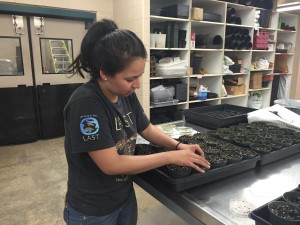Over the past few weeks here at A&M I have spent most of my time out in the field or in the green house learning from the graduate students that I have spent my time with. As I mentioned in my first blog, one of these graduate students working with Dr. Muthu is Blake Young who is a first year Masters Student starting his research on Johnsongrass weed control. Johnsongrass is common in the southern portion of the United States and is a significant problem for sorghum producers here in Texas.
My first few days working with Blake we spent time flagging his five acre plot dividing the different sections by treatments with bicycle flags to make it easier to see once the crop began to grow. This particular experiment has 6 treatments which are replicated 4 times. The six different treatments are different forms of Johnsongrass weed control and are summarized as follows:
| Treatment 1) application of Dual II Magnum pre followed by Atrazine at 12″ sorghum |
| Treatment 2) application of Dual II Magnum pre followed by Atrazine +Zest at 12″ sorghum |
| Treatment 3)Dual II Magnum pre followed by Atrazine +Zest at 12″ sorghum followed by Roundup dessicant prior to harvest |
| Treatment 4)Dual II Magnum pre followed by Atrazine +Zest at 12″ sorghum followed by roundup dessicant prior to harvest followed by chaff removal at harvest |
| Treatment 5) Dual II Magnum pre followed by Atrazine +Zest at 12″ sorghum followed by roundup dessicant prior to harvest followed by chaff removal at harvest followed by treating the regrowth at 30cm height after disking/shredding |
| Treatment 6) Dual II Magnum pre followed by Atrazine +Zest at 12″ sorghum followed by roundup dessicant prior to harvest followed by treat the regrowth with Select at 30cm height after shredding/disking |
The object of this study is to find the most efficient way to control for a resistant weed species in a production field. There is not yet resistant Johnsongrass in Texas but within 5 years there is expected to be, so Blake’s project looks forward into the future and finds weed control practices which are not solely dependent on an herbicide. I found this study particularly interesting because it may take an herbicide company as many as ten years (if not more) to release a new product to the market. It takes time to formulate a new chemical compound and it later must pass certain qualifications and restrictions that are imposed by the EPA and other regulation agencies. During this time, resistance in weeds builds up and there come complications when a farmer has no other way to control for these weeds, be it Johnsongrass or any other unwanted flora on his production field. By finding other ways to control weeds it allows farmers to have more options when it comes down to protecting their fields from lower yields.
There are also other interesting aspects to this study which I had never worked with before, one of them being the concept of genetic flow between Johnsongrass and sorghum. Because both of these plants are in the same species their genetic information may combine through pollination, and resistance from the sorghum may be passed on to the Johnsongrass weed species. This process however may take years to happen, so for this study an already resistant type of Johnsongrass was introduced. In order to make sure that the Johnsongrass transplants were resistant we tested first for visual signs of resistance. This process took some time as it required the team to grow the Johnson grass seeds in petri dishes to then transplant them into pots and later spray them in a spray chamber to analyze for any possible signs of herbicide damage. There are certain distinctions when it comes to working on an agricultural field for production and working for research. A spray chamber is mostly used to spray a certain number of transplants, but would probably not be used for production purposes. In that situation, a tractor sprayer or a backpack sprayer would be a better option as it can cover a larger area and number of plants in a smaller amount of time.
In the weeks to come I will be attending a couple of field days where I will be exposed to other research that Texas A&M University is taking part in and will be in contact with farmers who are interested and impacted by this research.



